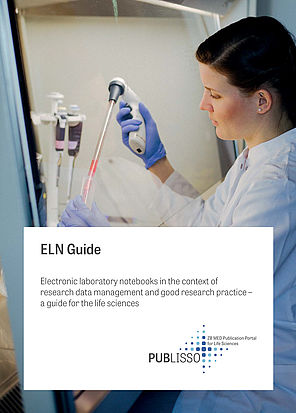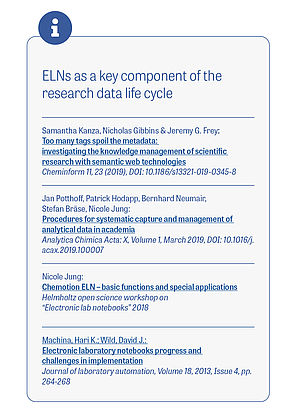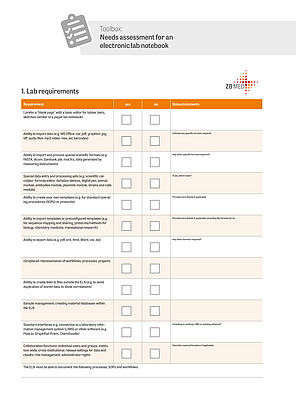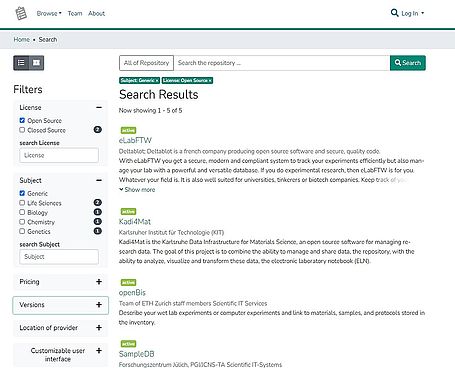Documenting research data: Electronic Lab(oratory) Notebooks
Lab notebooks play an important role in documenting research data. They provide clear documentation of the planning, execution and analysis of data resulting from experiments in all areas of scientific endeavour, including the life sciences. Lab notebooks are increasingly switching to electronic formats. They are a key tool in the creation of research data, and it is therefore essential to incorporate them in the research data management process.
PUBLISSO supports you in the selection and implementation process of an electronic laboratory notebook
The procedure for selecting and introducing an electronic laboratory notebook depends on the individual initial situation. Influencing factors are for example
- the scope of the needs to be covered: should an ELN be introduced for a researcher themselves, a small working group or an institute-wide use?
- the availability of in-house resources, e.g. in the IT area: is there sufficient potential to introduce an open-source product or an in-house developed tool and to develop it further in the long term, or should a commercial product be used?
In addition, an almost unmanageable number of software tools for electronic lab books are offered. They range from single solutions that can be integrated into one's own research environment via API to data management platforms in which the ELN is a component of a system of research software.
Benefits of an ELN
Raising awareness and communicating the advantages that an ELN offers over a paper-based lab notebook can help create a favorable climate for adopting a digital ELN tool up front.
With a well-founded decision when selecting a tool and good preparation of the introduction process, the best conditions are created for broad acceptance of the chosen solution. The PUBLISSO ELN Guide and ELN Filter are intended to help with this.
The ELN Guide
PUBLISSO has published the ELN Guide to assist in the selection and planning of the implementation process. Its intention is to make the process of selecting and introducing a suitable ELN tool tailored to the individual requirements and support of both researchers and information infrastructure managers.
In addition to basic knowledge, the introduction of various tools is illustrated using best practice examples. Infoboxes contain numerous links to further information.
Two toolboxes are available in the form of a needs assessment and a checklist of tasks. These can be downloaded separately under "Further links" on the right.
The ELN Finder
The ELN Finder is an electronic laboratory notebook selection service that helps researchers and FDM staff to choose the right tool for their laboratory or institution in the large market of ELN software.
Using a sophisticated metadata scheme, more than 40 filter criteria are available that reflect relevant features of an ELN, such as import-export capabilities, pricing and licensing model, or search functionality.
The resulting list of identified ELN tools is displayed in an overview. In addition to the filter criteria, the detailed view of the individual tools provides further information on the respective ELN, such as provider name, URL, brief description or reference users.
The entries in the ELN Finder are continuously maintained and updated by an editorial board consisting of numerous experts and users of ELN tools from all over Germany.
Video tutorial series on electronic lab notebooks
To give an impression of how to work with an ELN, we show similarities and differences of electronic lab books in five screencasts using two tools as examples. For this purpose, we have selected the free version of a commercial tool that runs in the provider's cloud, as well as a freely available open source tool that is operated locally as a client-server installation. In addition to the structure and menu navigation, three important functionalities of ELNs are demonstrated using a use case from biology: Workflows such as importing and exporting data or text editors, creating templates and creating inventory. It becomes clear that although the basic features of ELN tools are similar, the tools differ from each other in the implementation of the functions. Therefore, it is worthwhile to test a selection of tools based on your own needs and usability requirements.
Advice
Do you have any questions? Do you need further information? We would be happy to advise you on the selection and introduction of an electronic laboratory notebook. Feel free to write to us at forschungsdaten@zbmed.de!
Contact

Birte Lindstädt
Head of Research Data Management
Phone: +49 (0)221 999 892 646
Send mail
Beatrix Adam
Phone: +49 (0)221 999 892 641
Send mail
Birte Lindstädt in video podcast on electronic lab notebooks
Tutorial on ELN
Electronic Lab Notebook ELN: Labfolder & eLabFTW (five-part screencast series)
Related links
Toolbox ELN Needs Assessment (Open-Document-Version)
Toolbox ELN Needs Assessment (Excel-Version)
Metadata schema of the ELN Finder
The ELN topic in the ZB MED Blog (German only)
Contribution to the ELN Finder
Contribution to the 2th edition of the ELN-Wegweiser









